Science of Mindwell
About Mindwell
Mindwell’s meditations and mindfulness guides have brought together a number of practices and approaches to assist in the creation of a happy, fulfilled life that supports creativity, productivity, great relationships and well-being. They have been designed to assist in gaining the maximum benefit in the least amount of time.
The key components are:
Ambient music—to create the right mood using Isochronic tones and solfeggio frequencies to assist brainwave entrainment to help you achieve the appropriate mind-body state for your goals (from sleep to rest and calm, to energetic and highly functioning).
Breathing—techniques to complement or support a harmonious balance between mind and body, from relaxation to positive, focused activity.
Positive Language and Focused Intent—to build resilience and a sense of empowerment, encouraging you to support your health and well-being by trying new ideas, approaches or activities (aiding neuroplasticity) and by using the process of focused intent, to influence the Reticular Activating System (RAS) towards engaging with the world from a positive, pro–active perspective.
Imagination—an important methodology for programming the Reticular Activating System (RAS), and stimulating the electrochemical responses in the body towards feeling good, making positive, self–empowering choices and experiencing a more fulfilled life.
- http://awarenessact.com/category/health/
- http://www.eneuro.org/
- https://eocinstitute.org/meditation/increase-your-intelligence-with-meditation/
Mindwell’s meditations and guides are divided into 4 categories:
- Charging Up
- Full Thrust
- Powering Down
- Rest and Relaxation
Each category is linked to a brainwave range (alpha, beta, gamma, theta, delta) heart rate beats per minute (bpm) and solfeggio frequency pitches (174–963Hz) and isochronic tone range (1–40+ Hz) to assist brainwave entrainment. We also utilize positive language and focused intent methodologies to stimulate feelings of well-being, optimism, and pro–activity.
Each of our guided meditations and mindfulness guides contains some combination, generally all, of the four key components of:
Ambient music
To create the right mood using Isochronic tones and solfeggio frequencies to assist brainwave entrainment to help you achieve the appropriate mind-body state for your goals (from sleep to rest and calm, to energetic and highly functioning). Breathing Techniques to complement or support a harmonious balance between mind and body, from relaxation to positive, focused activity.
Positive Language and Focused Intent
To build resilience and a sense of empowerment, encouraging you to support your health and well-being by trying new ideas, approaches or activities (aiding neuroplasticity) and by using the process of focused intent, to influence the Reticular Activating System (RAS) towards engaging with the world from a positive, pro-active perspective.
Imagination
An important methodology for programming the Reticular Activating System (RAS), and stimulating the electrochemical responses in the body towards feeling good, making positive, self-empowering choices and experiencing a more fulfilled life. Simple, easy to grasp concepts relating to developing neuroplasticity, positive programming of the RAS, the importance of feeling good and making empowered, self–loving choices are woven into the guides and meditations to give weight and credibility to spoken content. As we are creatures of habit, the meditations and mindfulness guides are meant to help stimulate healthy habits. The guides also contain a menu covering a range of subjects and situations that you may not require on a regular basis, but can either dip in and out of from time to time, as the need arises, or use as ‘one offs’ to manage particular challenges. Some of the guides are cross-referencing for issues that could benefit from a broader approach to practice, gained by listening to other guides in the series.
Music and Frequencies
The brain naturally synchronizes its brainwave frequencies with the rhythm of its daily external stimuli. Typically, this is auditory, tactile or visual. This capacity is typically known as brainwave entrainment, brainwave synchronization or neural entrainment.
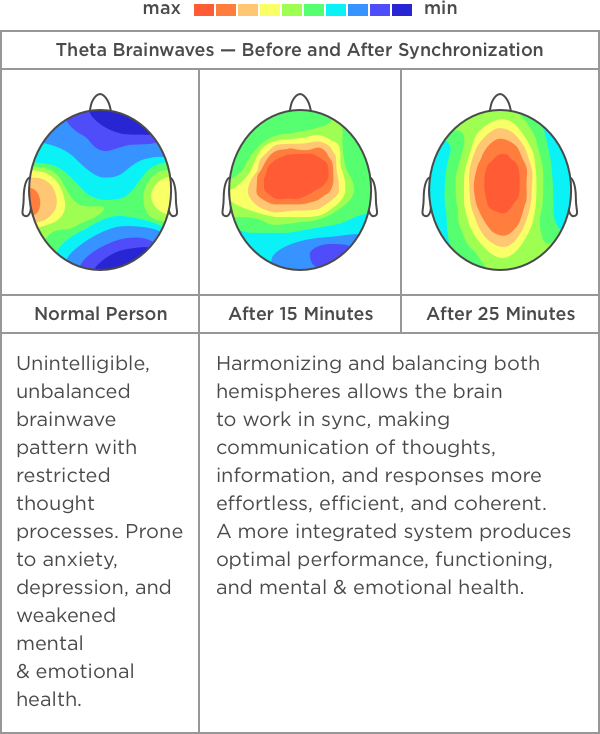
Different kinds of brainwave activity operate during our waking and sleeping states. Beta waves are faster and occur when we are awake, focused, energized and alert. Alpha waves are slower, and occur when we are relaxed and calm and can help us reduce anxiety and stress. Theta are slower still and signal deep relaxation, lighter sleep or anywhere in between. Delta are low-frequency waves produced in deep sleep. Gamma waves are the fastest. Less is known about Gamma waves, but it is believed that they can be linked to high levels of acumen, ingenuity, imagination, and percipience.nThese brain waves are measured in Hertz (Hz).
- Gamma waves 30–100+ Hz—Peak performance, flow
- Beta Waves 12–30 Hz—Awake, normal alert consciousness
- Alpha Waves 8–12 Hz—Relaxed, calm. Lucid, opening to meditative state
- Theta 4–7 Hz—Deep relaxation and meditation
- Delta 1–4 Hz—Deep sleep
At any one time, the brain operates with one dominant brainwave pattern. This can be influenced using a technique known as brainwave audio entrainment. This is where an audio signal, often embedded in ambient music, can influence dominant brainwave activity to a preferred frequency, allowing a person to synchronize with how they want to think and feel. So, a person who wishes to experience a calm state would choose an alpha frequency (between 8–12 Hz) to influence the brain towards less ‘thinking’ and more alertness to the present moment. When the mind is focused in the present, and reacting ONLY to what is happening in the present moment, a person can respond more naturally to whatever is happening in their environment. The body responds likewise by producing hormones and electrochemical responses that aid the functioning and well-being of the body. By being present, a person can adapt to the needs of the moment and the body responds by stimulating hormones that enable the appropriate response. A typical example, known as ‘fight or flight’, also referred to as hyperarousal or acute stress response, is where the body reacts to some kind of stressful or dangerous situation. The body’s sympathetic nervous system is activated, stimulating the adrenal glands to trigger the release of catecholamines such as adrenalin, noradrenalin and also cortisol. These increase heart rate, blood pressure, and breathing; slow digestion, and direct the blood flow towards major muscle groups, creating a short burst of energy and strength. This enables the person to assess the situation and decide on their strategy; whether to stay and fight or run away. Once the threat has passed, the body would ideally return to its pre-arousal levels, which takes between 20–60 minutes.
In modern daily life, most people’s stress is not directly, in the moment, life-threatening, but a constant presence focused on things such as tasks to be done, competing, feeling unworthy, lacking in some way, etc. This is fuel to Beta Wave activity, which is kept up for most of the day, whereas an ideal state would be to balance one’s brain wave activity throughout the day between gamma, beta, alpha or theta.
For the purposes of producing guided and unguided meditations for Mindwell, music was composed in consideration of the type of activity linked to each specific meditation. For example, the majority of meditations for rest, relaxation or sleep are set between 55–60 bpm (beats per minute) which is an ideal resting heart rate for most adults. Meditations, where the focus is more upbeat or action-oriented, are set around 90 bpm.
Each track is embedded with a solfeggio frequency and an isochronic tone that corresponds to the kind of activity that matches the daily or Vasomotoric Cycle.
The daily cycle starts with Waking or Charging Up, continues with Action or Expression, then Powering Down and finally Rest and Relaxation. You can plan your day by choosing how the cycle best fits your lifestyle and select which meditations will assist you in obtaining the optimum mental and physical state to achieve your goals. Some people may wish to energize in the morning, whereas others may feel that they need to calm down before they start their day. The cycle refers less to the time of day and more to the appropriate mood for the kind of activity wish to engage in.
The table below shows the relation of Solfeggio Frequencies and Isochronic Tones to brainwave activity.
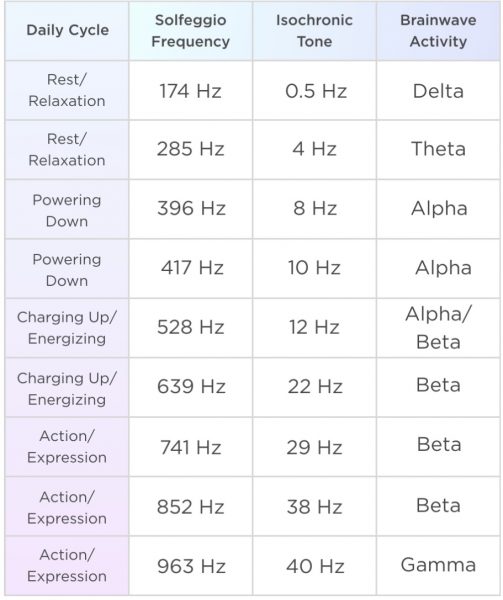
The tones and frequencies are generally embedded within each track between 78 and 58 dB. Their presence within the ambient sound is therefore subliminal. A louder presence or volume within the music is often considered off-putting and it is believed that the brain is able to detect the frequencies, even at a low dB setting and entrain itself.
Ancient Tones
Ancient Tones, called Isochronic Tones, can be used to influence the dominance of certain brainwaves. It is believed that their presence in ambient music can assist the listener to either enhance their focus and concentration or enter a meditative state, depending on the frequency used (see table above).
In this way, a person can start to achieve an overall more balanced approach to life, by practicing meditation and positive intent on a daily basis. An isochronic tone comprises a pitch (also known as a carrier frequency, for example, 174—see table), a brainwave frequency (alpha, beta, gamma, theta, delta) combined in a running alternation of tone and silence at a set rate. One full cycle of an isochronic tone is the length of the tone plus a silence (no tone) of the same length.
Solfeggio Frequencies
Solfeggio frequencies have become fairly popular among both meditation practitioners and producers of music for that specific purpose. Although there is no clear research providing empirical proof for their efficacy in healing, harmony, health, and well-being, they have their supporters and enthusiasts, particularly among those who, along with nuclear physics determine that all matter is ‘frequency’ and therefore is influenced, either harmoniously or disharmoniously, by frequency.
Mindwell’s meditations use solfeggio frequencies as the carrier frequencies for the embedded isochronic tones. Their presence may be beneficial either in any combination of the tones, the music itself, the rhythm (bpm) or the language of positive intent used in the voice-overs.
Breathing
Although most people have some knowledge of how air enters the body’s systems and what it does, few are aware of the importance of how the way one breathes influences that process.
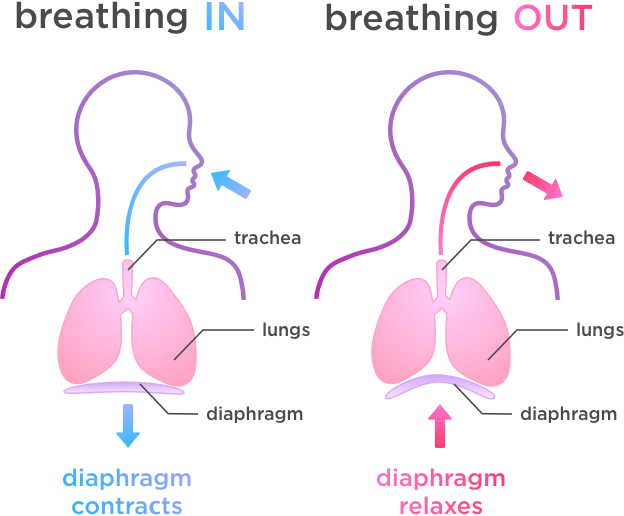
Breathing in when in a calm, relaxed state, causes the diaphragm to contract and move downwards on inhalation. This allows the chest cavity to increase, giving the lungs more space to expand. Oxygen-rich blood can then pass into the blood supply, while carbon dioxide is removed and finally expelled during exhalation. Deep breathing in this way, adds to the rhythm of calm and supports alpha and theta brainwaves, the patterns linked to relaxation, calm and meditation. It is important to be able to access this state over the course of any given day in order to assist the efficient running of the body’s systems.
Stress, causes the breathing to become shallow, and an increase of blood flow and oxygen to the brain in order to deal with the stressful situation. Shallow breathing means that the expulsion of CO2 is less efficient, as are other functions within the body, such as digestion. For many people in contemporary life, they have become so conditioned to stress, that they are unaware that they exist in that state almost constantly. Inevitably cognitive and biological functions become compromised or even impaired. The heart rate is generally increased. Stress is also believed to be a major factor causing inflammation within the body, stimulating the over–production of cholesterol, contributing to heart disease, one of the major causes of death in the developed world.
Learning (or reminding, as all are born instinctively knowing how to breathe properly) how to breathe so that the diaphragm moves downwards, allowing full expansion of the lungs, is key to well being. As is having a healthy heart rate. Shallow breathing stimulates beta brainwave functioning, or high alert, which, without respite, can tend towards obsessive thinking, feeling fearful, over–wrought or ‘wound up’, tense, snappy, on edge, etc. It can lead people to create more situations of the same degree, or exacerbate them. People then enter a cycle where they tend to react angrily, feel hurt, lay blame, self–harm, become aggressive, all of which feed into their own cycle.
Mindwell’s meditations focus on encouraging you to form healthy habits around breathing. The durations given between breathing in and out vary between meditations according to whether the focus is on beta activity (shorter breaths) or alpha, theta or delta activities requiring longer ones.
It is important to return the heart rate to a resting state for relatively short periods throughout the day. Work culture and practices often conflict with this, as in some cases, it is frowned upon if a person appears to be relaxing, going slower—or actually taking a lunch break. Paradoxically, if the work is stimulating or enjoyable, companies would get better results from employees if their employees felt comfortable managing their own day or workload and suitable rest periods.
Well-oxygenated and hydrated cells are critical to the optimum functioning and longevity of the body. The majority of meditations in the series tackle the former in order to encourage the habit of conscious breathing. One meditation has been devoted to being sufficiently hydrated, although this is unlikely to guarantee the regular practice of drinking water (as opposed to fluids. The body has much less work to do if it is only absorbing water. Many people believe they are hydrating themselves by drinking tea and coffee, however, both of these have a diuretic effect).
The Power of Positive Language
Positive affirmations have long been in use; however, the science around the power of affirmations is quite new.
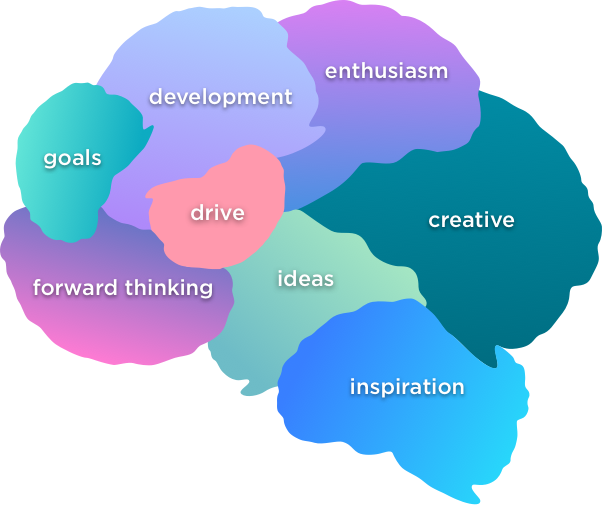
The body does not understand words, ideas or concepts. The language of the body is electro-chemical. It is the power of words to affect the electrochemical responses in the body that has the greatest impact. If a person simply mouths words or phrases deemed to be positive without engaging with the actual feelings linked to them, the benefits will be little or none.
The body has its own intent, which is optimum health and well-being. It is generally the primary goal of all children before they have been socially reconditioned, and it should be the goal of all adults who wish to live a healthy, productive and fulfilling life. Many people lead very productive lives, in the hope they will become fulfilling, but that tends to work for a few rather than the majority. And the sacrifice is usually health.
Because both mind and body are highly susceptible to forming habits around repeated ideas, behaviors or actions, the habits become automatic responses that occur before any thought process can take place. Meditation and mindfulness practices allow an individual to create a gap between the automatic response and acting upon it so that they can consider whether the action or response contributes to their best interests and goals or not. If it doesn’t, the habit can be ‘unlearned’ by directing the mind elsewhere, but it takes time for the neural pathway linked to the unwanted thought behavior to atrophy.
Neural pathways, do not have off buttons. Which is why so many people suffer from a chronic form of thinking where the mind obsesses upon certain ideas over and over. The electrochemical response is usually stress, which, if uncorrected, can lead to mental health issues, such as depression or despair.
Unhealthy thinking patterns circle around in the mind whenever a person focuses on them. The thoughts then seem to get lodged in such a way that the person finds it hard to concentrate on anything else. The electrochemical system responds with feelings that are meant to alert the individual to change their focus towards something more calming and less stressful, but that is a great challenge for many people to try alone.
The meditation and mindfulness guides assist you in refocusing your mind, helping the electrochemical system to readjust to a more beneficial hormonal balance. Because brainwave patterns are closely linked to a person’s thoughts, emotions, and biological chemistry, they determine how you react, how you see the world and how they feel they fit within it. It is vital for an individual to feel positive about her or himself, in order to help her or his ability to develop their unique gifts and talents and feel confident in sharing them.
References:
- https://www.scientificamerican.com/article/how-happiness-boosts-the-immune-system/
- https://www.britishcouncil.org/voices-magazine/famelab-whats-science-behind-smile
The Reticular Activating System
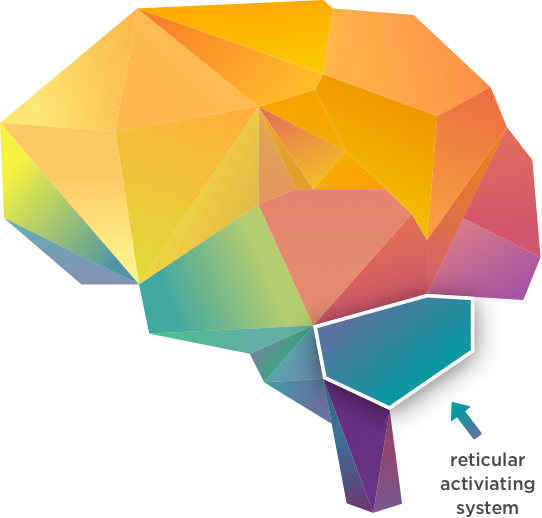
The focus of intent is rather like programming a computer. The brain contains a filter called the Reticular Activating System (RAS). The job of the RAS is to protect the conscious mind from being overwhelmed by too much data being collected constantly by the senses. Therefore, much of this ‘data’ is filtered away from the conscious mind, although stored by the subconscious. The RAS is not the arbiter of the information it sorts. It relies on the person to direct it. As the majority of people are unaware of this, they tend not to discriminate about where they focus their attention. But by focusing their attention on things they don’t like or want, paradoxically they are programming the RAS to home in on those things. Therefore, the things they like are more likely to be screened out and their attention directed towards the things they don’t like or want. After a while, the individual may start to assume that their entire life will only offer them the things they don’t want or like, leading to a pessimistic outlook.
Similarly, those who focus on positive things, opportunities, self-belief are far more likely to notice circumstances that reflect that focus, encouraging them to form expectations around things generally working out well for them.
Our meditation and mindfulness guides are designed to assist you in focusing your mind (and therefore their RAS) on things that make them feel good, a belief in self and a willingness to adapt or try new things (supporting increased neuro-plasticity). The guides encourage users to train themselves into the habit of using positive language. Imagination is a powerful tool for igniting this process and is another regular feature of the guides.
MoodShift™
Mindwell’s Patent Pending MoodShift was designed to assist in transitioning one’s mood to a more desirable state.nHumans often feel extreme moods and need to quickly change from negative to positive. Mindwell gives the ability to define a current state of mind, and to give the desired end state (or direction), and have a resultant program created to optimize achieving that desired state or direction through sensory input. This involves selecting a current mood and the desired mood on a two-dimensional graph, and then our proprietary algorithms create a sequence of audio clips designed to help shift mood in that desired direction.nUtilizing a bank of hundreds of custom guides and meditations that have been overlaid with isochronic tones and solfeggio frequencies; Mindwell steps through a series of questions to understand the current and desired mood. We then calculate the best program to move the mood based on those parameters.
